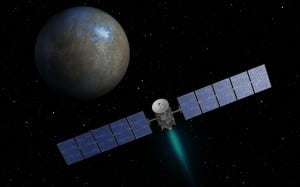Latest News

This artist’s concept shows NASA’s Dawn spacecraft heading toward the dwarf planet Ceres. Photo: NASA/JPL-Caltech
[Via Satellite 12-30-2014] Mission controllers at NASA’s Jet Propulsion Laboratory (JPL) have beamed the programmed maneuvers for the Dawn spacecraft to begin its approach phase as it nears Ceres, the largest body in the asteroid belt. Dawn was recently behind the sun relative to Earth during a period of time known as solar conjunction that limited communication with antennas on Earth. The spacecraft emerged 640,000 kilometers from Ceres, approaching at 750 kilometers per hour.
Dawn uses ion propulsion to travel interplanetary distances with a xenon thruster. According to NASA JPL, Dawn’s accumulated thrust time over the past five years exceeds that of any other spacecraft.
For 14 months during 2011 and 2012, Dawn explored Vesta, the second largest body in the asteroid belt. Ceres has stronger similarities to terrestrial worlds, and it is believed that gravitational perturbations from Jupiter stunted its growth. The asteroid has differentiated layers underneath its surface, including a thick mantle of ice and, possibly, a subterranean ocean.
“Ceres is almost a complete mystery to us,” said Christopher Russell, principal investigator for the Dawn mission, based at the University of California, Los Angeles. “Ceres, unlike Vesta, has no meteorites linked to it to help reveal its secrets. All we can predict with confidence is that we will be surprised.”
Get the latest Via Satellite news!
Subscribe Now